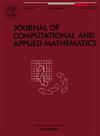Optimal L2 error estimates of mass- and energy- conserved FE schemes for a nonlinear Schrödinger–type system
IF 2.1
2区 数学
Q1 MATHEMATICS, APPLIED
Journal of Computational and Applied Mathematics
Pub Date : 2024-10-10
DOI:10.1016/j.cam.2024.116313
引用次数: 0
Abstract
In this paper, we present an implicit Crank–Nicolson finite element (FE) scheme for solving a nonlinear Schrödinger–type system, which includes Schrödinger–Helmholz system and Schrödinger–Poisson system. In our numerical scheme, we employ an implicit Crank–Nicolson method for time discretization and a conforming FE method for spatial discretization. The proposed method is proved to be well-posedness and ensures mass and energy conservation at the discrete level. Furthermore, we prove optimal error estimates for the fully discrete solutions. Finally, some numerical examples are provided to verify the convergence rate and conservation properties.
非线性薛定谔型系统的质量和能量守恒 FE 方案的最优 L2 误差估计
本文提出了一种隐式 Crank-Nicolson 有限元(FE)方案,用于求解非线性薛定谔型系统,包括薛定谔-赫尔姆霍兹系统和薛定谔-泊松系统。在我们的数值方案中,我们采用隐式 Crank-Nicolson 方法进行时间离散化,并采用符合 FE 方法进行空间离散化。我们证明了所提出的方法具有良好的假设性,并能确保离散水平上的质量和能量守恒。此外,我们还证明了完全离散解的最优 L2 误差估计。最后,我们提供了一些数值示例来验证收敛速度和守恒特性。
本文章由计算机程序翻译,如有差异,请以英文原文为准。
求助全文
约1分钟内获得全文
求助全文
来源期刊
CiteScore
5.40
自引率
4.20%
发文量
437
审稿时长
3.0 months
期刊介绍:
The Journal of Computational and Applied Mathematics publishes original papers of high scientific value in all areas of computational and applied mathematics. The main interest of the Journal is in papers that describe and analyze new computational techniques for solving scientific or engineering problems. Also the improved analysis, including the effectiveness and applicability, of existing methods and algorithms is of importance. The computational efficiency (e.g. the convergence, stability, accuracy, ...) should be proved and illustrated by nontrivial numerical examples. Papers describing only variants of existing methods, without adding significant new computational properties are not of interest.
The audience consists of: applied mathematicians, numerical analysts, computational scientists and engineers.

 求助内容:
求助内容: 应助结果提醒方式:
应助结果提醒方式:


